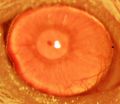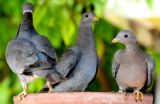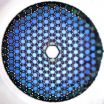(Press-News.org) A Boston-based scientific collaborative, led by Harvard Stem Cell Institute (HSCI) researchers, has discovered a way to collect the best cell type for regenerating a damaged cornea—the clear membrane that covers the pupil and directs light into the back of the eye. The investigators report in the journal Nature that purified human stem cells can be used to improve long-term vision in mice. The team is now pursuing FDA-approval for the technique before moving on to patient clinical trials.
The study, lead by co-senior investigators Natasha Frank, MD, and Markus Frank, MD, was a highly collaborative effort, with work done at Massachusetts Eye and Ear/Schepens Eye Research Institute, Boston Children's Hospital, Brigham and Women's Hospital, and the US Department of Veterans Affairs Boston Healthcare System.
Corneal blindness is a clouding of vision that results when blood vessels grow into the cornea. It can be caused by an injury, infection, or autoimmune disease that destroys an actively regenerating population of stem cells located in an area behind the cornea, called the limbus. Limbal stem cell transplants from an uninjured eye or deceased organ donor have had promising results, but outcomes have been inconsistent.
"Previously published work on limbal epithelial cell grafts showed that when more than three percent of transplanted cells were stem cells, transplants were successful—less than three percent and the transplants were not, "said HSCI Affiliated Faculty member Natasha Frank.
"The question in the field then was whether we could enrich the limbal stem cells. But until this study there was no specific marker that could isolate these cells," added Frank, who is a physician of the VA Boston Healthcare System and Brigham and Women's Hospital, and a Harvard Medical School assistant professor of medicine in the Division of Genetics at Brigham and Women's Hospital.
The biological marker the researchers found is the ABCB5 protein, which is located on the surface of limbal stem cells. The team then developed an antibody that could tag limbal stem cells in a general sample of human limbal cells, making it possible to purify only the cells responsible for successful limbal cell transplants.
The researchers transplanted purified limbal stem cells from adult humans into mice with corneal blindness and checked to see if the corneas had regrown 5 weeks later, as well as 13 months later. They found that the mouse corneas looked normal, with the same thickness and protein expression as corneas in healthy mice.
"I think a very exciting part of the study is that even though there is a lot of evidence that adult stem cells contribute to tissue regeneration, what we see is basically the first evidence that you can take adult stem cells and regrow the organ that's been damaged," Frank said.
The research team next hopes to find a way to replicate limbal stem cells so that a single donor eye can produce enough transplantable cells to help several patients. They will also be partnering with biopharmaceuticals companies to produce commercial qualities of the ABCB5 antibody for humans, and they are planning to further collaborate with co-author Victor Perez, MD, a professor of ophthalmology at the Bascom Palmer Eye Institute in Miami, to move the techniques used in the current study into clinical trials.
"This finding will now make it much easier to restore the corneal surface. It's a very good example of basic research moving quickly to translational application," said Bruce Ksander, PhD, an associate scientist at Schepens Eye Research Institute and co-first author on the study with postdoctoral fellow Paraskevi Kolovou, MD.
INFORMATION:
The research was supported by a 2013 Harvard Stem Cell Institute Seed Grant, the National Institute of Neurological Disorders and Stroke, the Veterans Administration, the National Cancer Institute, the Department of Defense, the National Institutes of Health, the Corley Research Foundation, the Medical Eye Bank of Western Pennsylvania, the Howard Hughes Medical Institute and the Life Sciences Research Foundation.
Cited: Ksander, et. al., ABCB5 is a limbal stem cell gene required for corneal development and repair. Nature. (July 2, 2014), doi: 10.1038/nature13426
Scientists can now screen for stem cells that enhance corneal regrowth
Discovery is expected to quickly translate into improved human therapies
2014-07-02
ELSE PRESS RELEASES FROM THIS DATE:
Die-offs of band-tailed pigeons connected to newly discovered parasite
2014-07-02
A new pathogen has been discovered by scientists investigating major
die-offs of pigeons native to North America, according to studies led
by the University of California, Davis, and the California Department
of Fish and Wildlife.
Scientists were able to implicate this new parasite, along with the
ancient parasite Trichomonas gallinae, in the recent deaths of
thousands of Pacific Coast band-tailed pigeons. The die-offs occurred
during multiple epidemics in California's Central Coast and Sierra
Nevada mountain ranges. Scientists named the new pathogen Trichomonas
stableri.
Avian ...
Computer-automated, time-lapse embryo photography may increase success of IVF
2014-07-02
PHILADELPHIA - Using computer-automated, time‐lapse photography of embryos in the laboratory during in-vitro fertilization may improve embryo selection, potentially increasing the chances of pregnancy among women undergoing the procedure, according to new research from the Perelman School of Medicine at the University of Pennsylvania and five other fertility centers. Results of the study were presented this week at the 30th annual European Society of Human Reproduction and Embryology (ESHRE) meeting in Munich, Germany.
The researchers at Penn and their collaborators ...
Novel intravaginal ring shows promise for HIV prevention
2014-07-02
A novel intravaginal ring implanted with anti-retroviral drug tablets, or pods, demonstrated sustained and controlled drug release and safety over 28 days, according to a paper published ahead of print in Antimicrobial Agents and Chemotherapy. The ring, designed to prevent transmission of HIV, was tested in pig-tailed macaque monkeys, and is engineered to be inexpensive, all the better for use in developing countries, says corresponding author Marc Baum.
One of the two drug combinations tested in the ring had been shown in three clinical trials to prevent HIV—some of ...
Veterans with muscle injuries and mental health conditions more likely to end service
2014-07-02
ANN ARBOR, Mich. — Sixty percent of U.S. Army soldiers who were unable to return to a military career after an Iraq deployment couldn't do so because of a muscle, bone or joint injury and nearly half had a mental health diagnosis, according to a new study from the University of Michigan and VA Ann Arbor Healthcare System.
Lower rank, which indicated socioeconomic status, was also a predictor of poor health outcomes among service members, according to the research that appears in the Journal of Bone and Joint Surgery and was led by a former Army Major who served in ...
Japanese gold leaf artists worked on a nanoscale
2014-07-02
Ancient Japanese gold leaf artists were truly masters of their craft. An analysis of six ancient Namban paper screens show that these artifacts are gilded with gold leaf that was hand-beaten to the nanometer scale. Study leader Sofia Pessanha of the Atomic Physics Center of the University of Lisbon in Portugal believes that the X-ray fluorescence technique her team used in the analysis could also be used to date other artworks without causing any damage to them. The results are published in Springer's journal Applied Physics A: Materials Science & Processing.
Gold leaf ...
A tale of a tail -- Kangaroos' powerful 'fifth leg'
2014-07-02
A Simon Fraser University study on how kangaroos use their tails as a 'fifth' leg is providing new insight into the diversity of biological movement, and specific insight into why we walk the way we do.
Published today in the Royal Society journal Biology Letters, the study, led by professor Max Donelan of SFU's Locomotion Laboratory, found kangaroos, commonly viewed as hoppers, move with a "pentapedal" gait, planting their tails on the ground in combination with their front and hind legs.
"We measured the forces the tail exerts on the ground and calculated the mechanical ...
Stem cell type resists chemotherapy drug
2014-07-02
PROVIDENCE, R.I. [Brown University] — A new study shows that adipose-derived human stem cells, which can become vital tissues such as bone, may be highly resistant to the common chemotherapy drug methotrexate (MTX). The preliminary finding from lab testing may prove significant because MTX causes bone tissue damage in many patients.
MTX is used to treat cancers including acute lymphoblastic leukemia, the most common form of childhood cancer. A major side effect of the therapy, however, is a loss of bone mineral density. Other bone building stem cells, such as bone marrow ...
Hollow optical fibers for UV light
2014-07-02
This news release is available in German.
If you want to send light on a trip through optical fibres with as little loss as possible, you should opt for infrared light, as is the case, for example, in the telecommunication networks worldwide. For certain applications, such as spectroscopic investigations on ions or atoms, however, (laser) light in the ultraviolet range is required. But this type of light would quickly damage conventional optical fibres. Researchers from the Max Planck Institute for the Science of Light (MPL) in Erlangen/Germany and of the QUEST Institute, ...
Inspired by nature, researchers create tougher metal materials
2014-07-02
Drawing inspiration from the structure of bones and bamboo, researchers have found that by gradually changing the internal structure of metals they can make stronger, tougher materials that can be customized for a wide variety of applications – from body armor to automobile parts.
"If you looked at metal under a microscope you'd see that it is composed of millions of closely-packed grains," says Yuntian Zhu, a professor of materials science and engineering at NC State and senior author of two papers on the new work. "The size and disposition of those grains affect the ...
Behavioral therapy in pediatric antidepressant treatment reduces likelihood of relapse
2014-07-02
DALLAS – July 2, 2014 – Cognitive behavioral therapy in addition to medication improves the long-term success of treatment for children and adolescents suffering from depression, a new UT Southwestern Medical Center study indicates.
Based on the results of a clinical trial conducted at UT Southwestern and Children's Medical Center of Dallas, depression relapse rates were substantially lower in a group of youth who received both forms of treatment versus medication alone.
"Continuation-phase strategies designed to reduce the high rates of relapse in depressed youths ...
LAST 30 PRESS RELEASES:
Scalable and healable gradient textiles for multi‑scenario radiative cooling via bicomponent blow spinning
Research shows informed traders never let a good climate crisis go to waste
Intelligent XGBoost framework enhances asphalt pavement skid resistance assessment
Dual-function biomaterials for postoperative osteosarcoma: Tumor suppression and bone regeneration
New framework reveals where transport emissions concentrate in Singapore
NTP-enhanced lattice oxygen activation in Ce-Co catalysts for low-temperature soot combustion
Synergistic interface engineering in Cu-Zn-Ce catalysts for efficient CO2 hydrogenation to methanol
COVID-19 leaves a lasting mark on the human brain
Scientists use ultrasound to soften and treat cancer tumors without damaging healthy tissue
Community swimming program for Black youth boosts skills, sense of belonging, study finds
Specific depressive symptoms in midlife linked to increased dementia risk
An ‘illuminating’ design sheds light on cholesterol
Who is more likely to get long COVID?
Study showcases resilience and rapid growth of “living rocks”
Naval Research Lab diver earns Office of Naval Research 2025 Sailor of the Year
New Mayo-led study establishes practical definition for rapidly progressive dementia
Fossil fuel industry’s “climate false solutions” reinforce its power and aggravate environmental injustice
Researchers reveal bias in a widely used measure of algorithm performance
Alcohol causes cancer. A study from IOCB Prague confirms damage to DNA and shows how cells defend against it
Hidden viruses in wastewater treatment may shape public health risks, study finds
Unlock the power of nature: how biomass can transform climate mitigation
Biochar reshapes hidden soil microbes that capture carbon dioxide in farmland
Reducing saturated fat intake shows mortality benefit, but only in high-risk individuals
Manta rays create mobile ecosystems, study finds
Study: Mixed results in using lipoic acid to treat progressive multiple sclerosis
Norbert Holtkamp appointed director of Fermi National Accelerator Laboratory
New agentic AI platform accelerates advanced optics design
Biologists discover neurons use physical signals — not electricity — to stabilize communication
Researchers discover that a hormone can access the brain by hitchhiking
University of Oklahoma researcher awarded funding to pursue AI-powered material design
[Press-News.org] Scientists can now screen for stem cells that enhance corneal regrowthDiscovery is expected to quickly translate into improved human therapies




